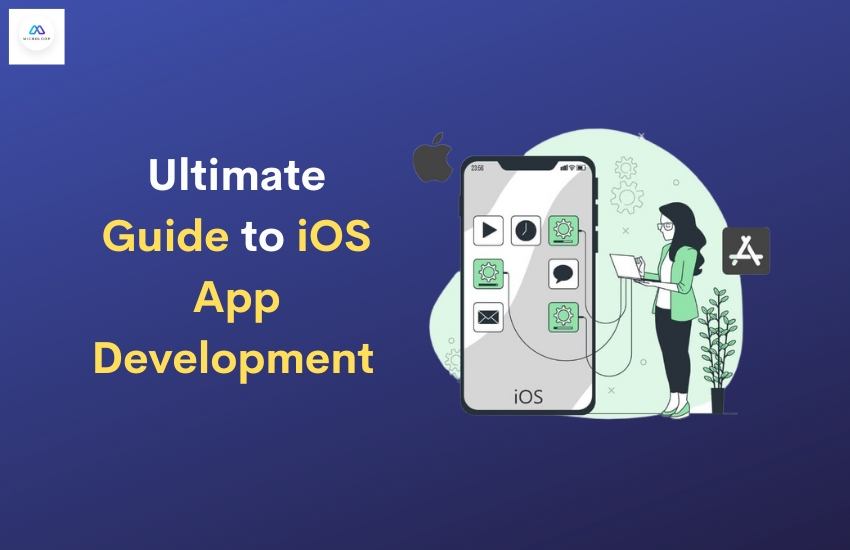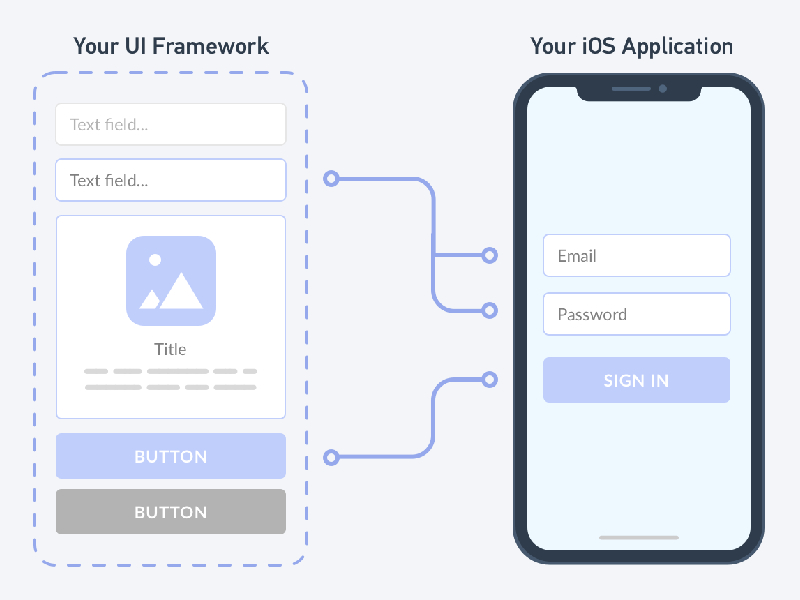
Close


A decade ago, the Indian market was all about Android mobile users. However, in recent times, there has been a drastic increase in the number of iOS users, which resulted in the IT industries that previously focused on Android development, have now given equal importance to iOS app development.
Calling all the entrepreneurs! Prepare yourself for a journey where you will discover
about iOS app development and explore different types of iOS apps and their frameworks.
Get ready to grab some in-depth knowledge and determine which app type, hybrid, native, or web app, is suitable for your business.
Furthermore, explore Flutter and Ionic frameworks and ascertain whether they support mobile app development for iOS and Android platforms.
Before we proceed, let us introduce you to the best iPhone app development service provider in Australia, who has completed iOS app development projects and established itself as an industry pioneer.
Microloop IT Solution, Australia's best IT service provider, has pioneered mobile app development services that include iOS, Android, React Native, and Xamarin. Moreover, their expertise also extends to provide you with software development, UI-UX development, web development, and much more.
Let's start exploring!
iOS application development refers to making mobile applications friendly for iPhone users. It involves writing code in Swift programming or Objective- C languages to develop applications that iPhone owners can download and use. The iOS app development process involves various stages, including designing, coding, testing, and deploying optimized applications for the iOS platform.
The Swift programming language is a powerful, modern programming language designed for Apple devices. The language offers clean syntax, strong typing, and a vast standard library, making it easier for developers to write and develop efficient and effective code.
On the other hand, Objective-C language was the app used for iOS application development. However, with the widespread adoption of Swift, it has become the preferred choice for most app development projects. Nevertheless, Objective-C is still utilized to maintain and update legacy iOS applications.
Also See:

It is a type of iOS app development software developed specifically for a particular platform or operating system. It is built using tools, frameworks, and platform-specific programming languages provided by the platform's developers.
The purpose of a native app is to fully take advantage of the features and capabilities of the targeted platform, delivering a seamless user experience.
Few characteristics of iOS development:
Native apps are developed using platform-specific programming languages. E.g. - iOS Native apps are written in Swift or Objective -C using Apple development tools, whereas Android Native apps are written using Java or Kotlin using Android Studio.
The app has direct access to the native application programming interfaces (API) and features provided by the platform. This feature allows the developers to utilize camera access, push notifications, and GPS.
The app is known for its high performance and speed because they are optimized to run directly on the underlying platform. They can fully utilize the hardware and software capabilities, resulting in a smoother user experience.
A web app is a type of iPhone application development software that doesn't require users to download it onto their devices. Instead, it can be accessed via any search engine such as Safari, Chrome, and Mozilla Firefox. Web apps are relatively fast and straightforward to build but not versatile and quick as native apps.
They are built using web development technologies like HTML, JavaScript, and CSS. One of the key advantages of web apps is their flexibility to adapt to different screen sizes and orientations of iOS devices.
Features of the web app:
Web apps can run on different platforms and devices that include iOS, Android, and desktops as they are accessed through web browsers.
Since web apps are hosted on servers, updates can be easily implemented without requiring users to download and install new versions.
Web apps do not require approval from the app store, meaning you have more flexibility and control over the deployment process. You can quickly release updates and new features without going through the lengthy approval process imposed by the app marketplace.
It is a type of iOS application development software that combines elements of web and native apps. With the help of web technologies such as HTML, CSS, and JavaScript, they can be installed on various platforms. Let's explore a few features of the app:
With the help of frameworks like Flutter and React Native, a Hybrid app creates a user interface that closely resembles a Native app. With a Hybrid app, you get to experience smooth transitions, animations, and access to native device features.
It can be easily updated without requiring users to download and install new versions. Developers can quickly deploy updates to the app's web-based components, and users will receive the updated versions the next time they access the app.
Building apps for each platform can be time-consuming and costly. However, building it on a Hybrid app can be more cost-effective due to its ability to reach a broader audience and reduce the resources required for maintenance and development.

One of the best choices so far by all iOS developers because it allows them to build high-performance apps, resulting in quicker deployment times and a better return on investment.
One merit of this framework is that developers do not need to learn any additional language because the app works using JavaScripti XML(JSX).
The app has a powerful JavaScript library for creating native apps across multiple platforms. Moreover, it enables the development of platform-specific variations of several components, making it simpler to use a single codebase across various platforms.
Features of React Native are:
The React Native framework allows developers to reuse code across different platforms. The framework uses the learn once, write anywhere approach, which means you can use the same code for both iOS and Android platforms. This significantly reduces development time and cost, enabling developers to focus on other essential coding activities.
It consists of third-party plugins and libraries through the npm package manager. These plugins offer various benefits, such as navigation, image processing, and form handling. These well-maintained plugins make coordinating multiple features in the iOS app easier.
Reactive app uses an API through which you can customize what you want your user interface to look like. Accordingly, it will handle the UI to render the underlying operations. It has the feature of a predictive user interface where changes in UI are automatically updated based on the app. This indirectly helps the developers to focus on the final output rather than handling the low-level UI updates.
The ionic framework provides tools for building native iOS and Android applications using familiar web libraries, languages, and frameworks. It can employ a variety of UI components, such as mobile navigation, routing, and animations, enabling developers to concentrate on creating apps instead of working on UI designs and elements. Let's explore one by one:
The Iconic development provides a comprehensive library of ready-to-use UI elements. These elements include buttons, forms, menus, and much more, enabling developers to create visually appealing and functional interfaces for iOS apps.
Iconic extensive library of pre-built components in Ionic facilitates rapid prototyping, speeding up the development cycle. Using web technologies like HTML, CSS, and JavaScript, developers can minimize the learning curve and focus more on the actual development process using the in-build code.
The developers can create and customize iOS app development software. It offers the flexibility for personalizing the app's appearance, behavior, and functionality according to the requirement or brand language.
Moreover, developers can choose UI/UX elements, handle data effectively, and integrate with native device features based on their needs. This level of customization enables the creation of highly tailored
One of the powerful iOS development software created by Google, known for its efficiency and ability to facilitate quick coding procedures. With Flutter, developers can deploy a single base code on both iOS and Android frameworks, making it appropriate for mobile app creation.
The app can update the widgets' new version, because of which you can quickly create responsive mobile applications. Its UI tool is fully equipped with configurable devices, facilitating the rapid development of native applications.
Let's explore a few features of Flutter:
A material guide developed by Google is a design language providing a set of guidelines, components, and patterns for creating visually appealing user interfaces. The developers can quickly implement material design principles and UI elements in their iOS apps, ensuring a consistent and polished design.
With the help of motion-rich APIs, Flutter offers developers to create animations within their iOS apps. The Flutter framework helps developers create complex animations and apply them to various UI elements, creating an engaging and dynamic user experience with iOS.
A cross-platform framework that allows developers to use a single codebase for both Android and iOS platforms. With the approach write once, run anywhere approach, you can ensure that developers can consistently use it. This significantly reduces the time and effort of developers and lets them focus on the development part.
Xamarin is among the most popular mobile app frameworks known for its solid shared codebase and fully integrated mobile apps. Leveraging the power of the C programming language, Xamarin enhances application quality while providing support for many tools.
Let's Explore its Features:
It enables the developers to create native iOS user interfaces using native controls and UI elements. It provides access to a full range of iOS APIs, allowing developers to build visually appealing and responsive interfaces that seamlessly blend with the iOS platform.
It allows for code sharing across multiple platforms, including iOS, Android, and Windows. Developers can write and reuse their codes on different platforms, saving time and effort. This code-sharing capability helps maintain consistency and reduces the need for platform-specific code.
The developers in iOS app development have the capability to use a rich set of tools, debugging capabilities, and extensions to streamline the development process.
So far, we have learned about the terms of iOS app development and types of iOS apps such as native, web, and hybrid apps. This helped you understand how easily you can develop and access apps. Additionally, we learned popular frameworks such as Ionic, Xamarin, and React Native, understanding their unique features and benefits that make them used frequently in iOS development.
To hire the best experts to develop your app, consult Microloop IT Solution, Australia, which helps you develop user-friendly apps that users easily navigate. They believe in the seamless integration of the Apple ecosystem, creating a more flexible UI and better customer experience.